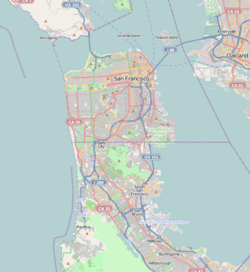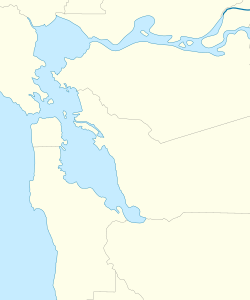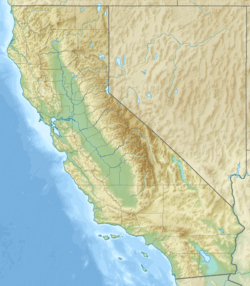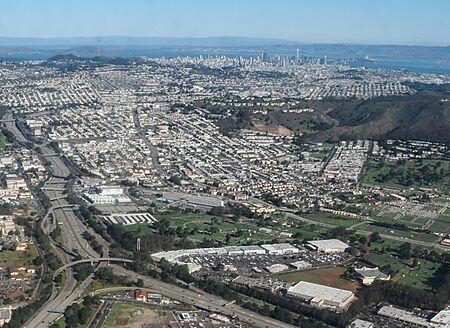Colma, California facts for kids
Quick facts for kids
Colma, California
|
|||
|---|---|---|---|
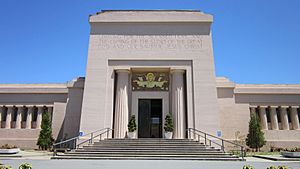
Holy Cross Cemetery
|
|||
|
|||
| Motto(s):
"It's great to be alive in Colma"
|
|||
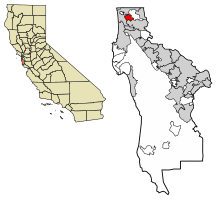
Location of Colma in San Mateo County, California
|
|||
| Country | United States | ||
| State | California | ||
| County | San Mateo | ||
| Incorporated as "Lawndale" | August 5, 1924 | ||
| Name changed to "Colma" | November 17, 1941 | ||
| Area | |||
| • Total | 1.89 sq mi (4.90 km2) | ||
| • Land | 1.89 sq mi (4.90 km2) | ||
| • Water | 0.00 sq mi (0.00 km2) 0% | ||
| Elevation | 121 ft (37 m) | ||
| Population
(2020)
|
|||
| • Total | 1,507 | ||
| • Density | 796.93/sq mi (307.78/km2) | ||
| United States Census Bureau | |||
| Time zone | UTC−8 (PST) | ||
| • Summer (DST) | UTC−7 (PDT) | ||
| ZIP Code |
94014
|
||
| Area code(s) | 650 | ||
| FIPS code | 06-14736 | ||
| GNIS feature ID | 1658303 | ||
| Website | www.colma.ca.gov | ||
Colma is a small town in San Mateo County, California. It is located on the San Francisco Peninsula in the San Francisco Bay Area. The name "Colma" comes from an Ohlone word meaning "springs."
In 2020, about 1,507 people lived in Colma. The town was officially started in 1924. A very interesting fact about Colma is that most of its land is used for cemeteries. Because of this, the number of people buried there (around 1.5 million) is much, much larger than the number of people who are alive. This is why Colma is often called "the City of the Silent." The town even has a funny motto: "It's great to be alive in Colma."
Contents
What Does "Colma" Mean?
The most common idea for the name "Colma" is that it comes from an Ohlone word. This word means "springs" or "many springs."
There are other ideas about where the name came from. Before 1872, the area was known as "Station" or "School House Station."
Colma's History
The community of Colma began in the 1800s. It was a group of homes and small shops along El Camino Real. It was also near the San Francisco and San Jose Railroad line. Early churches, like Holy Angels Catholic Church, were built here. The community also started its own fire department.
In the early 1900s, a man named Heinrich von Kempf moved his plant nursery to Colma. He needed more space for his growing business. Von Kempf helped turn the Colma community into an official farming town. He became Colma's first treasurer.
Colma was also a popular place for big boxing matches in the early 20th century. Famous boxers like Stanley Ketchel and Jack Johnson fought here.
Why So Many Cemeteries?
Colma became home to many cemeteries because of a rule in San Francisco. In 1900, San Francisco stopped allowing new burials inside its city limits. Then, in 1912, it decided to move most of the existing cemeteries out of the city.
Between 1920 and 1941, about 150,000 bodies were moved to Colma. This cost about $10 for each grave and marker. Many of these bodies came from the Lone Mountain Cemetery in San Francisco. If no one paid the fee, the remains were reburied in large shared graves. The old grave markers were sometimes used for other things in San Francisco. For example, some were used as drain gutters or to help build breakwaters near the St. Francis Yacht Club. You can even see them at low tide on Ocean Beach.
The main train line that ran through Colma was later used to move coffins. Years later, this same path was bought by BART for its train extension to San Francisco International Airport.
The town was first officially named Lawndale in 1924. This was mainly done by the cemetery owners. However, another city in California was already called Lawndale. So, the post office kept the name Colma. In 1941, the town officially changed its name back to Colma.
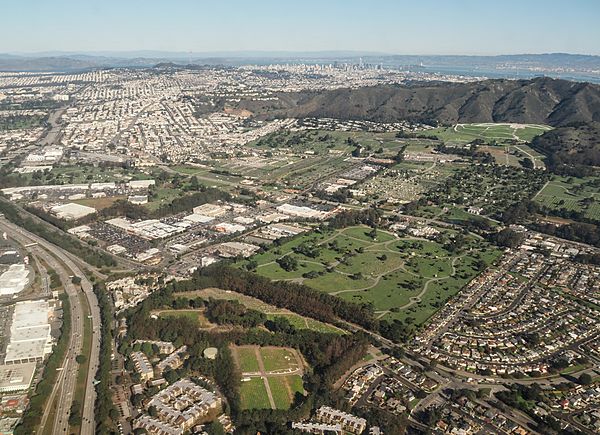
Famous People Buried in Colma
Many famous people who died in San Francisco are buried or reburied in Colma. Here are some of them:
- Cypress Lawn Memorial Park
- William Henry Crocker, a rich businessman
- Charles de Young, who started the San Francisco Chronicle newspaper
- Phineas Gage, a famous person from the 1800s known for a medical case
- William Randolph Hearst, a newspaper tycoon
- Ed Lee, the first Asian American Mayor of San Francisco
- Willie McCovey, a baseball Hall of Famer
- Hills of Eternity Memorial Park and Home of Peace Cemetery (Jewish cemeteries)
- Wyatt Earp, a famous lawman, is buried next to his wife, Josephine Marcus Earp
- Levi Strauss, who created denim trousers
- Holy Cross Cemetery
- Joseph Alioto, a San Francisco mayor
- Pat Brown, a governor of California
- Beniamino Bufano, a sculptor known for peace monuments
- Joe DiMaggio, a famous baseball player for the New York Yankees
- A.P. Giannini, who founded Bank of America
- Vince Guaraldi, a jazz musician
- Capt. Michael A. Healy, a U.S. government officer
- James D. Phelan, a senator
- Woodlawn Memorial Park Cemetery
- Emperor Norton, a San Francisco celebrity from the late 1800s
- Eternal Home Cemetery (Jewish Cemetery)
- Bill Graham, a music promoter
- Greek Orthodox Memorial Park
- George Christopher, a San Francisco mayor
- Serbian Cemetery
- Boris Pash, a Russian-American military officer
- Greenlawn Memorial Cemetery
- James Rolph, a San Francisco mayor and governor of California
- Japanese Cemetery
- George Shima, a businessperson
Businesses in Colma
At first, most people in Colma worked in jobs related to the many cemeteries. But since the 1980s, Colma has grown to have many different types of businesses. Now, there are lots of stores and car dealerships. These businesses bring in more money for the town government through sales taxes. In 1986, the 280 Metro Center opened in Colma. It was one of the first large shopping centers of its kind.
| Name | Image | Founded | Community | Size | Notes |
|---|---|---|---|---|---|
| Tung Sen | ? | Chinese | ? | These four cemeteries are actually in Daly City, next to Cypress Lawn. | |
| Hoy Sun | 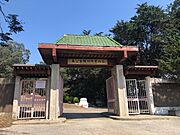 |
? | Chinese | ? | |
| Chinese Christian | 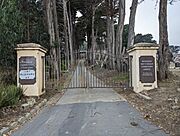 |
? | Chinese | ? | |
| Russian Sectarian | ? | Russian | ? | ||
| Holy Cross | 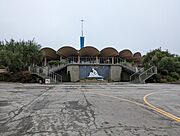 |
Jun 3, 1887 | Roman Catholic | ? | The Holy Cross Mausoleum is where many Archbishops of San Francisco are buried. |
| Home of Peace | 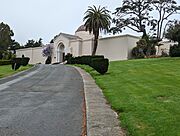 |
Jan 1, 1889 | Jewish | 20 acres (8.1 ha) | This cemetery is in the northern part of the area. |
| Hills of Eternity | 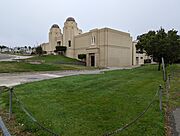 |
20 acres (8.1 ha) | This cemetery is in the southern part of the area. | ||
| Salem | 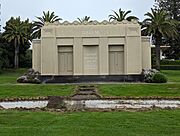 |
Dec 20, 1891 | Jewish | 17 acres (6.9 ha) | |
| Cypress Lawn | 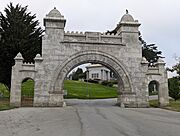 |
1892 | For all faiths | 148 acres (60 ha) | This cemetery is split into two parts by El Camino Real. |
| Mount Olivet | 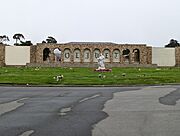 |
1896 | 65 acres (26 ha) | This cemetery is now part of Cypress Lawn. | |
| Italian | 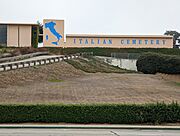 |
1899 | Italian | 35 acres (14 ha) | |
| Serbian | 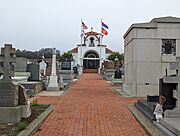 |
1901 | Christian Orthodox | 16 acres (6.5 ha) | |
| Japanese | 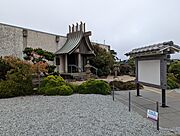 |
Jun 1901 | Japanese | 2 acres (0.81 ha) | |
| Eternal Home |  |
Jul 1901 | Jewish | 25 acres (10 ha) | It also has a special garden for remembering the Jewish community. |
| Greenlawn |  |
1903 | For all faiths | 47 acres (19 ha) | |
| Woodlawn | 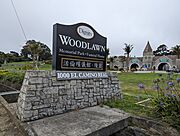 |
Oct 29, 1904 | For all faiths | 92 acres (37 ha) | It was originally smaller. |
| Sunset View | 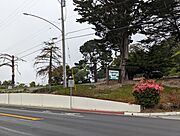 |
1907 | For all faiths | ? | This site is now used for Cypress Hills Golf Course. |
| Greek Orthodox | 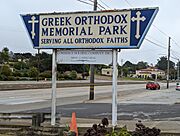 |
1935 | Eastern Orthodox | 8 acres (3.2 ha) | It was officially opened in April 1936. |
| Pets Rest | 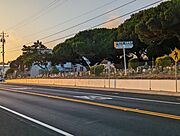 |
1947 | For pets | 5 acres (2.0 ha) | |
| Hoy Sun | 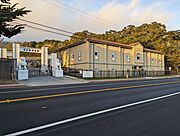 |
1988 | Chinese | 8 acres (3.2 ha) | This land was once part of the Cypress Hills Golf Course. |
| Golden Hills | 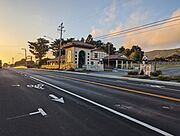 |
Feb 23, 1994 | Chinese | 14 acres (5.7 ha) | This land was also acquired from the Cypress Hills Golf Course. |
Geography and Land
Colma covers an area of about 1.9 square miles (4.9 square kilometers). All of this area is land. About 73% of the town's land is used for its 17 cemeteries. Colma is next to Daly City to the north and west. It borders South San Francisco to the south. To the east, it is next to San Bruno Mountain State Park.
Colma is located on the San Francisco Peninsula. It sits in a low area between San Bruno Mountain and the northern part of the Santa Cruz Mountains. A creek called Colma Creek flows through the town. It goes from San Bruno Mountain to San Francisco Bay.
Getting Around Colma
BART trains serve Colma with two stations: Colma station and South San Francisco station. You can also use SamTrans buses for public transportation in the city.
There are three main roads that go north and south through Colma. These are Junipero Serra Boulevard, El Camino Real, and Hillside Boulevard. They are all connected by Serramonte Boulevard, which runs through the middle of Colma.
Schools in Colma
Colma has one private school, Holy Angels School. This is a Catholic school for students from preschool to 8th grade.
For public schools, Colma is part of the Jefferson Elementary School District. It has two schools in Colma: Garden Village Elementary (for grades K–5) and Benjamin Franklin Intermediate (for grades 6–8). Most high school students from Colma go to Westmoor High School.
Population Facts
| Historical population | |||
|---|---|---|---|
| Census | Pop. | %± | |
| 1880 | 188 | — | |
| 1930 | 369 | — | |
| 1940 | 354 | −4.1% | |
| 1950 | 297 | −16.1% | |
| 1960 | 500 | 68.4% | |
| 1970 | 537 | 7.4% | |
| 1980 | 395 | −26.4% | |
| 1990 | 1,103 | 179.2% | |
| 2000 | 1,191 | 8.0% | |
| 2010 | 1,792 | 50.5% | |
| 2020 | 1,507 | −15.9% | |
| U.S. Decennial Census | |||
In 2006, people often said that Colma had about 1,500 living residents. They also said it had 1.5 million people buried underground!
2010 Census Information
The 2010 United States Census showed that Colma had 1,792 people. The population density was about 938.6 people per square mile.
Here's a look at the different groups of people living in Colma in 2010:
- White: 34.6%
- African American: 3.3%
- Native American: 0.4%
- Asian: 34.5%
- Pacific Islander: 0.5%
- Other races: 20.4%
- Two or more races: 6.3%
People who identified as Hispanic or Latino made up 39.5% of the population.
Most people (98.4%) lived in homes. About 21.8% of the population was under 18 years old. The average age in Colma was 36.4 years.
2000 Census Information
In the census of 2000, there were 1,191 people living in Colma. The population density was about 624.6 people per square mile.
About 24.7% of the people were under 18 years old. The average age was 37 years. The median income for a household in Colma was about US$58,750.
See also
 In Spanish: Colma (California) para niños
In Spanish: Colma (California) para niños




